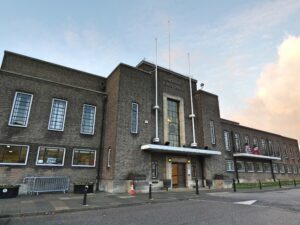
Havering Council produced a report identifying significant pockets of deprivation. (Credit: LDRS)
(Written by Local Democracy Reporter, Sebastian Mann)
A stark report put before the council cabinet on Wednesday evening (10th April) identified Harold Hill and Rainham as particularly troubled areas, where residents experience “poorer outcomes” compared to others.
In the most deprived areas of the London borough, male residents will live an average of 7.3 years less than residents in the least deprived decile. Women are worse affected, living an average of 7.6 years less.
But even some residents living in more affluent parts of Havering face “extreme poverty”.
During the monthly meeting, council officials outlined a plan to tackle poverty and help residents build “financial resilience”.
Among its many aims, the plan will aim to help low-income residents maximise their funds, by encouraging and promoting access to healthy and affordable food.
Additionally, the council will put a “strong focus” on residential developments including social housing and affordable rent, to help alleviate housing pressures.
It will also look into becoming an accredited London Living Wage employer.
Age UK, one of the council’s partners in the plan, has also increased its capacity to help over-50s access various government benefits, inclduing council tax allowances and Universal Credit.
However, concerns were raised about the council’s own financial picture.
In February, the authority accepted a £54million loan from the central government to offset its multi-million pound budget shortfall.
Councillor Martin Goode, from East Havering Residents’ Group, asked if the council’s partners in the NHS would be providing any funding, or if it would fall on the council.
Labour councillor Keith Darvill responded that, despite the “pressures” it faced, the authority would be “maximising” the service it provides.
The council will also look at available grants and “other streams” of income, housing director Patrick Odling-Smee said.
He added: “Where we’re looking at actions to take, we will have to look at resources and what each partner can contribute.”
Cllr Goode acknowledged that it was “very awkward” to budget for when relying on grants, but stressed the importance of “frontline services” running well.
The borough has also been badly hit by the rising cost of living, with food banks regularly having to purchase food to keep up with demand.
During a council-run consultation in December 2023, the top issue for residents (based on a sample size of 3,723) was the economy, followed by healthcare needs.
People struggling to afford their heating bills may have a direct impact on their health and wellbeing, the council has warned.
In the report, the authority’s health team wrote: “For the most vulnerable, those who are older, or with long term conditions or disabilities, the impact of a cold, mouldy, or damp home can have a very significant impact on their healthy life expectancy.”
Though employment rates are relatively high and Havering is less deprived than other boroughs – such as Tower Hamlets, Newham and Camden – the average household income is below the London standard.
Based on the most recent data, published in 2018, households earn around £44,430 a month, against the London rate of £51,770.
The council identified the most ‘income- and employment-deprived’ wards as Gooshays, Havering Park and Heaton.
Over the past year, its ‘cost of living working group’ has worked to help residents. The council reported an increase in benefits uptake among eligible residents, as well the establishment of an ‘energy doctor’ scheme, with AgeUK and Mears, to offer people free advice on energy bills.
‘Warm’ and ‘cool’ hubs were also set up across the borough, which benefitted 5,000 people.
Tags: Havering Council, Havering